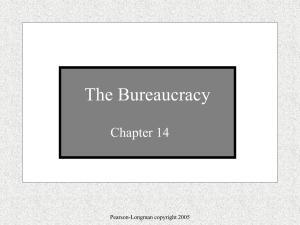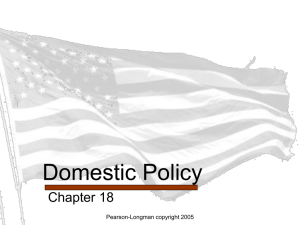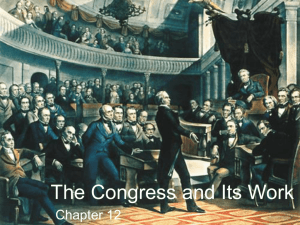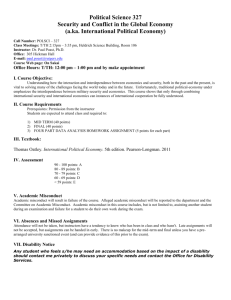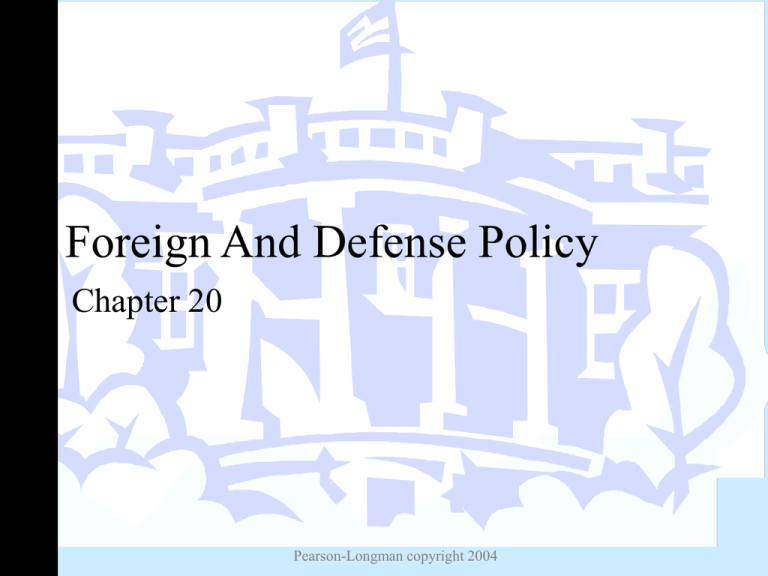
Foreign And Defense Policy
Chapter 20
Pearson-Longman copyright 2004
Elections, Presidents, and
Foreign Policy
• Foreign policy is the conduct of relations among
nation-states.
– Most important foreign policy issues involve war and
peace.
– Also involves economic trade among nations and other
types of interactions.
• Two presidency theory
– Wildavsky: explains why presidents exercise greater
power over foreign affairs than over domestic policy.
Pearson-Longman copyright 2004
Need for Fast Action
• Foreign policy decisions often require rapid,
decisive action.
• Ex: Bush sent marines to Haiti in 2004 to
guard U.S. interests as the government of
Haitian President Aristide fell.
• Secretary of State briefed Congress, but no
approval was sought.
Pearson-Longman copyright 2004
Voters’ Focus on Presidents
• Voters expect president to act in area of foreign
affairs.
• Support the president in crisis situations.
– “Rally ‘round the flag” effect: The tendency for the
public to back presidents in moments of crisis.
– While voters are supportive initially, they tend to
demand quick results, and often forget foreign policy
accomplishments, particularly if domestic economic
issues become concerns.
Pearson-Longman copyright 2004
Pearson-Longman copyright 2004
Limited Role of Interest Groups
• On domestic issues, there is often great
interest group involvement and influence.
• On foreign policy issues, interest groups are
not as visible or as powerful.
– Council on Foreign Relations
• influential based on quality of advice not ability to
mobilize voters.
– AIPAC
• has strong voice due to a strong domestic
constituency.Pearson-Longman copyright 2004
Congressional Role
• Congress follows a “self-denying
ordinance” when it comes to foreign affairs.
• Not equipped to determine defense policy.
• Has delegated to the president most of the
major foreign policy decisions.
• Some clashes with the president
– Ex. Vietnam
Pearson-Longman copyright 2004
Foreign Policy Responsibilities of
the President and Congress
• President plays the dominant role in foreign
policy.
• Constitution gives responsibility to
Congress as well.
• Treaty-making power divided between the
president and the Senate.
Pearson-Longman copyright 2004
Pearson-Longman copyright 2004
War Power
• Hamilton: “Of all the concerns of
government, the direction of war most
peculiarly demands the exercise of power by
a single hand.”
• Chief Justice John Marshall interpreted
president’s constitutional powers broadly.
– “The President is the sole organ of the nation
in its external relations and its sole
representative with foreign nations.”
Pearson-Longman copyright 2004
War Power
• Prior to Civil War presidents seldom acted on their
own on military matters.
– Abraham Lincoln first to action based on an expanded
interpretation of commander in chief.
– Theodore Roosevelt: sent ships to Japan without
Congressional approval of cost
– Not since WWII has Congress officially declared war.
– Truman fought the Korean War without any
congressional declaration at all.
Pearson-Longman copyright 2004
War Power
• U.S. v. Curtiss-Wright (1936)
– Supreme Court decision in which Congress is given the
authority to delegate foreign policy responsibilities to
the president.
• Youngston Sheet and Tube Co. v. Sawyerv (1952)
– Case in which the Supreme Court placed limits on the
executive power of the president.
• Taken together: Presidents have more
constitutional discretion with respect to foreign
versus domestic questions. But, presidents may
not act contrary to the expressed will of Congress.
Pearson-Longman copyright 2004
War Powers Resolution
• Vietnam War
– Focused attention on the issue of executive authority
– Eisenhower and Kennedy sent “advisors”
– Johnson asked for Tonkin Bay Resolution
• Authorized response to attack with armed force (was told that
U.S. had NOT invaded N. Vietnam’s territorial waters – but in
reality they had)
• Gave president the authority “to take all necessary measures”
to repel any attacks and to “prevent further aggression.”
• Resolution was legal basis for a war that would last 8 more
years but based on misinformation from the Johnson
administration.
Pearson-Longman copyright 2004
War Powers Resolution
• 1973 congressional resolution requiring the
president to notify Congress formally upon
ordering U.S. troops into military action.
– Troops must be withdrawn unless Congress
approves the presidential decision within 60
days after notice of the military action has been
received.
Pearson-Longman copyright 2004
War Powers Resolution & 9/11
• At Bush’s request passed war on terrorism resolution.
– One dissenting vote in the House.
– President authorized to “use all necessary and appropriate force
against those nations, organizations, or persons he determines
planned, authorized, committed or aided the terrorist attacks that
occurred on Sept 11, or harbored such organizations or persons, in
order to prevent any future acts of international terrorism.”
– No limit placed on timer period in which president may act.
– Second resolution focused continuing threat posed by Iraq. But
required Bush to exhaust “diplomatic or other peaceful means” of
resolving the conflict prior to resorting to force.
Pearson-Longman copyright 2004
Treaty Power
• Treaties are official agreements with foreign
countries that are ratified by the Senate.
• The president’s power to negotiate treaties
is the most circumscribed of all the
president’s powers.
– Ex: Woodrow Wilson and the Versailles Treaty
– Ex: Clinton and the Comprehensive Nuuclear
Test Ban Treaty
Pearson-Longman copyright 2004
Executive Agreements
• Executive agreements
– Are agreements with foreign countries that require only
a presidential signature.
– Power not found explicitly in the Constitution.
– First one: 1817 limiting the size of the U.S. and Great
Britain’s naval forces on the Great Lakes – James
Monroe
• Most executive agreements either are extensions
of treaties ratified by the Senate or involve routine
presidential actions that have been authorized by
Congress.
Pearson-Longman copyright 2004
Pearson-Longman copyright 2004
Foreign Policy Institutions: From
Cold War to Homeland Defense
• Cold War
– The 43-year period (1946-1989) during which
the United States and the Soviet Union
threatened one another with mutual destruction
by nuclear warfare.
– Institutions designed to meet this threat.
– 9/11 has focused attention and reevaluation of
institutions in light of new threat.
Pearson-Longman copyright 2004
The Cold War and the Post Cold-War
World
• Cold War view: Bipolar
– Divided into two centers of power: U.S. and its allies
and the Soviet Union and its allies.
• Containment
– U.S. policy that attempted to stop the spread of
communism in the expectation that this system of
government would eventually collapse on its own.
– Proved successful.
• New focus was on the areas of dangerous
instability in the world.
Pearson-Longman copyright 2004
Pearson-Longman copyright 2004
State Department
• State Department is the agency responsible for conducting
diplomatic relations.
• Secretary of State
– Officially, the president’s foreign policy adviser and head of the
Dept. of State.
• Ambassadors
– The head of a diplomatic delegation to a major foreign country.
– Many political appointments. Bush appointed 19 of his top fundraisers as ambassadors. But usually trained career diplomats.
• Embassy
– The structure that houses ambassadors and their diplomatic aides
in the capital cities of foreign countries.
Pearson-Longman copyright 2004
Defense Department
• Department of Defense is the cabinet department
responsible for managing the U.S. armed forces.
• Secretary of Defense
– The president’s chief civilian adviser on defense
matters and overall head of the army, navy and air
force.
• Joint Chiefs of Staff
– The heads of all the military services, together with a
chair and vice-chair nominated by the president and
confirmed by the Senate.
Pearson-Longman copyright 2004
Pearson-Longman copyright 2004
Pearson-Longman copyright 2004
Central Intelligence Agency
• This agency is primarily responsible for
gathering and analyzing information about
the political and military activities of other
nations.
– Was not created until the Cold War began.
– The National Security Act of 1947
– Most controversial has been the authority to
conduct covert operations.
Pearson-Longman copyright 2004
National Security Council
• Created in 1947 because so many departments and
agencies needed to work together to formulate U.S. Cold
War policy.
• Located inside the White House Executive Office of the
President
• Coordinates U.S. foreign policy.
• National Security Advisor
– Council assisted by a staff under the direction of the national
security advisor. Has more access to the president than other
foreign policy advisors & can be influential.
– Condoleeza Rice is George W. Bush’s NSA.
Pearson-Longman copyright 2004
Ideals, Interests, and the Worldwide
Campaign Against Terror
• Idealists
– Those who say that U.S. foreign policy should
be guided primarily by democratic principles.
• Realists
– Those who say that U.S. foreign policy best
protects democracy when it safeguards its own
economic and military strength.
Pearson-Longman copyright 2004
Strategies for Nation-Building
• Nation building
– Interventions designed to enhance democratic practices
in other countries. Realists are less likely to support this
practice.
– At outset of 2000, G.W. Bush questioned efforts to
secure human rights and other efforts to enhance
democratic practices in other countries.
– After 9/11, Bush administration policies changed
sharply. Nation-building became an important objective
in the war on terror.
Pearson-Longman copyright 2004
Role of International Organizations
• United Nations
– Organization of all nation-states, whose
purpose is to preserve world peace and foster
economic and social development throughout
the world.
– Idealists and realists have different feelings
toward the U.N.
Pearson-Longman copyright 2004
Russia, China and Human Rights
• Idealists and Realists differ on the appropriate
U.S. policy toward Russia and China.
– Idealists argue that the United States should use
economic and political means to force China to alter its
policies.
– Idealists would sanction Russia for its ongoing war
Chechnya.
– Realists are more cautious. Do not offend friends and
economic partners.
– Realists believe the goals of the U.S. can be better
achieved by encouraging the spread of free markets and
international trade.
Pearson-Longman copyright 2004
The Politics of World Trade: New
Alliances?
• Trade Policy
– 1947 General Agreements on Tariffs and Trade
– Truman signed it – called it an executive
agreement
– Action set the pattern for trade policy ever
since.
– Executive branch takes the lead although
Congress must approve the overall framework
within which policies are determined.
Pearson-Longman copyright 2004
The Politics of World Trade: New
Alliances?
• Trade policy has grown contentious.
– Labor and environmental groups concerned that firms in
other countries need not follow the labor and
environmental regulations to which U.S. firms are subject.
– North Atlantic Free Trade Agreement (NAFTA):
eliminated trade barriers among U.S., Canada and Mexiconarrowly passed Congress.
– World Trade Organization (WTO): a trade body much
more powerful than GATT with enforcement and trade
resolution mechanisms.
– Ultimately, politics will influence the resolution of this
policy arena.
Pearson-Longman copyright 2004

